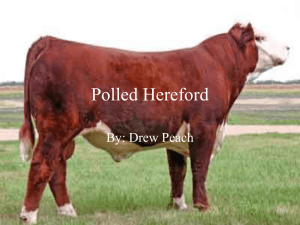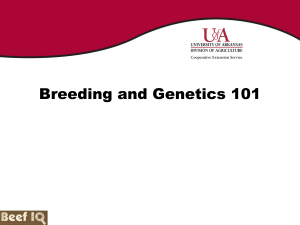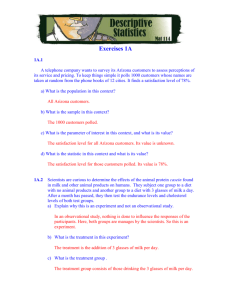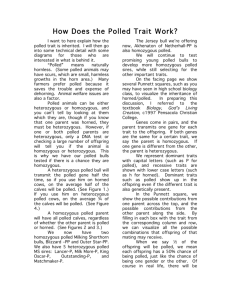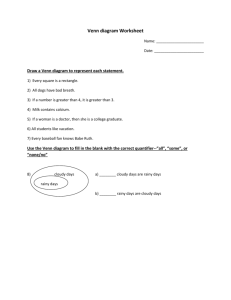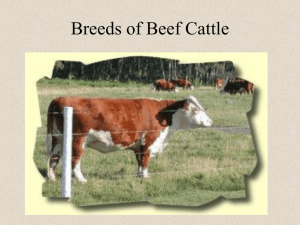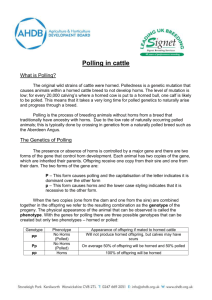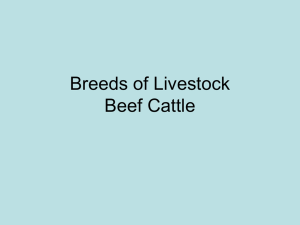DOCX* 714 KB
advertisement
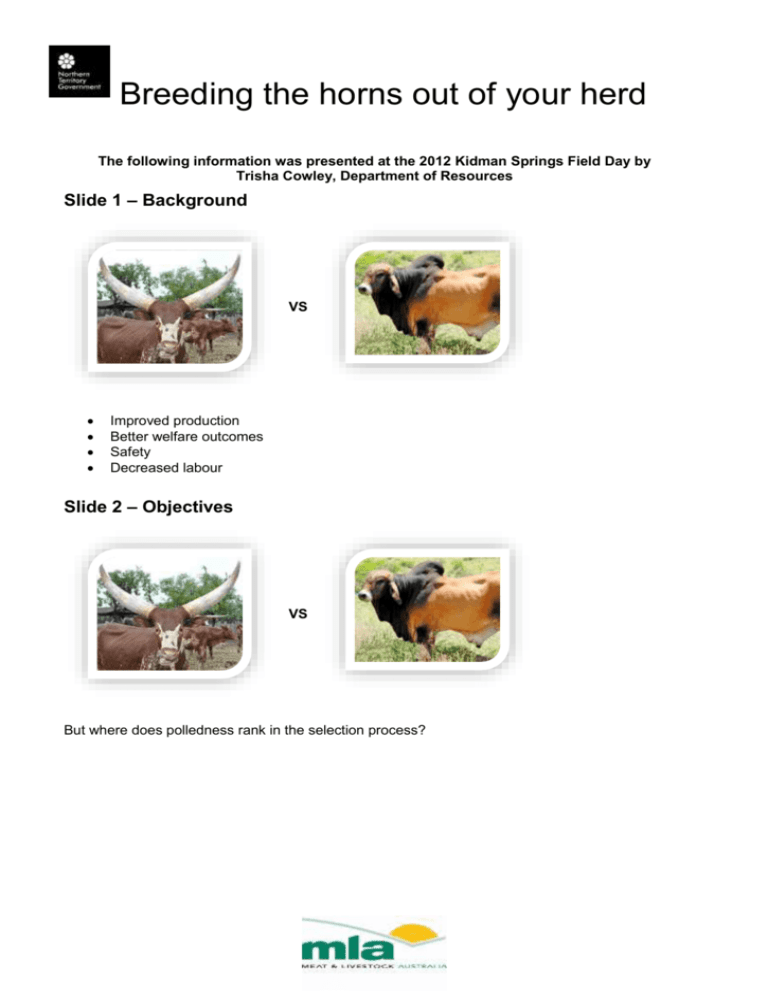
Breeding the horns out of your herd The following information was presented at the 2012 Kidman Springs Field Day by Trisha Cowley, Department of Resources Slide 1 – Background VS Improved production Better welfare outcomes Safety Decreased labour Slide 2 – Objectives VS But where does polledness rank in the selection process? Breeding the horns out of your herd Trisha Cowley, Department of Resources Slide 3 - Where does polledness fit in? • What are you selecting a bull to achieve? Slide 4 - Before a bull is polled it needs to: • • • • • • Be reproductively sound Be structurally sound Have good temperament Produce fertile daughters Produce progeny that will make you money Produce progeny that suit your market Don’t buy a bull because he’s polled, buy a bull because he has all this AND he’s polled! Slide 5 - Inheritance of polledness 101 • • Controlled by 1 gene in many Bos Taurus breeds Polled Gene o Polled form (P) o Horned form (H) o Polled form is dominant o (so PP and PH look polled) Breeding the horns out of your herd Trisha Cowley, Department of Resources Slide 6 – PP • • • • Two copies of the Polled allele Homzygous polled “True polled” Can only pass on a Polled allele to offspring Slide 7 – PH • • • Has one copy of the polled allele and one copy of the horned allele Heterozygous polled Passes on a polled allele to 50% of its offspring and a horned allele to 50% Slide 8 - Polledness in Brahmans • • Not so simple in Brahmans – Scur gene, African horn gene Major difference in PH animals – Scurred, polled or horned Breeding the horns out of your herd Trisha Cowley, Department of Resources Slide 9 - PP versus PH • • • • Both can look polled!! But PH will pass on a horned form of the polled to 50% of its progeny…. Desirable to be able to distinguish between them DNA tests existed for use in Bos taurus cattle, but did not work well in Bos indicus Slide 10 • • Beef CRC set about developing gene markers for these hypothesised genes Validated in Brahman, Hereford, Droughtmaster, Santa Gertrudis, Limousin, Brangus, Tropical Composite, Simmental, Charolais, Shorthorn. Slide 11 - Polled Gene Marker Test • • • • DNA test used to determine an animal’s horn/poll genotype When gene is not isolated, markers help to tag a gene of interest Works well in Brahman, Hereford, Simmental, Droughtmaster, Santa Gertrudis Ambiguous results – 11% in Brahman Slide 12 - Validation in Brahmans Breeding the horns out of your herd Trisha Cowley, Department of Resources Slide 13 - PP versus PH – genotype Slide 14 - PP versus PH – phenotype 90% of PP progeny won’t need dehorning, versus 50% of PH Breeding the horns out of your herd Trisha Cowley, Department of Resources Slide 15 - Some practicalities… • Complications of the interaction of the African Horn Gene Slide 16 - Some practicalities… • • • • • Frequency of polled animals in the Brahman Availability of Polled Brahmans Dangers of single trait selection Are polled animals inferior? – Spiral deviation NO – Sheath structure NO How long will it take? – 35 years vs 8…. Slide 17 - Other options • • • • Controlled mating, segregation PH bulls Crossbreeding – Belmont Red, Bonsmara, Senepol, Droughtmaster Breeding own nucleus herd Slide 18 - Summary • • • • Polled Gene Marker Test isn’t perfect – but best we’ve got PP sires will get you there faster Going to take long time so start now Balanced selection is critical as always
